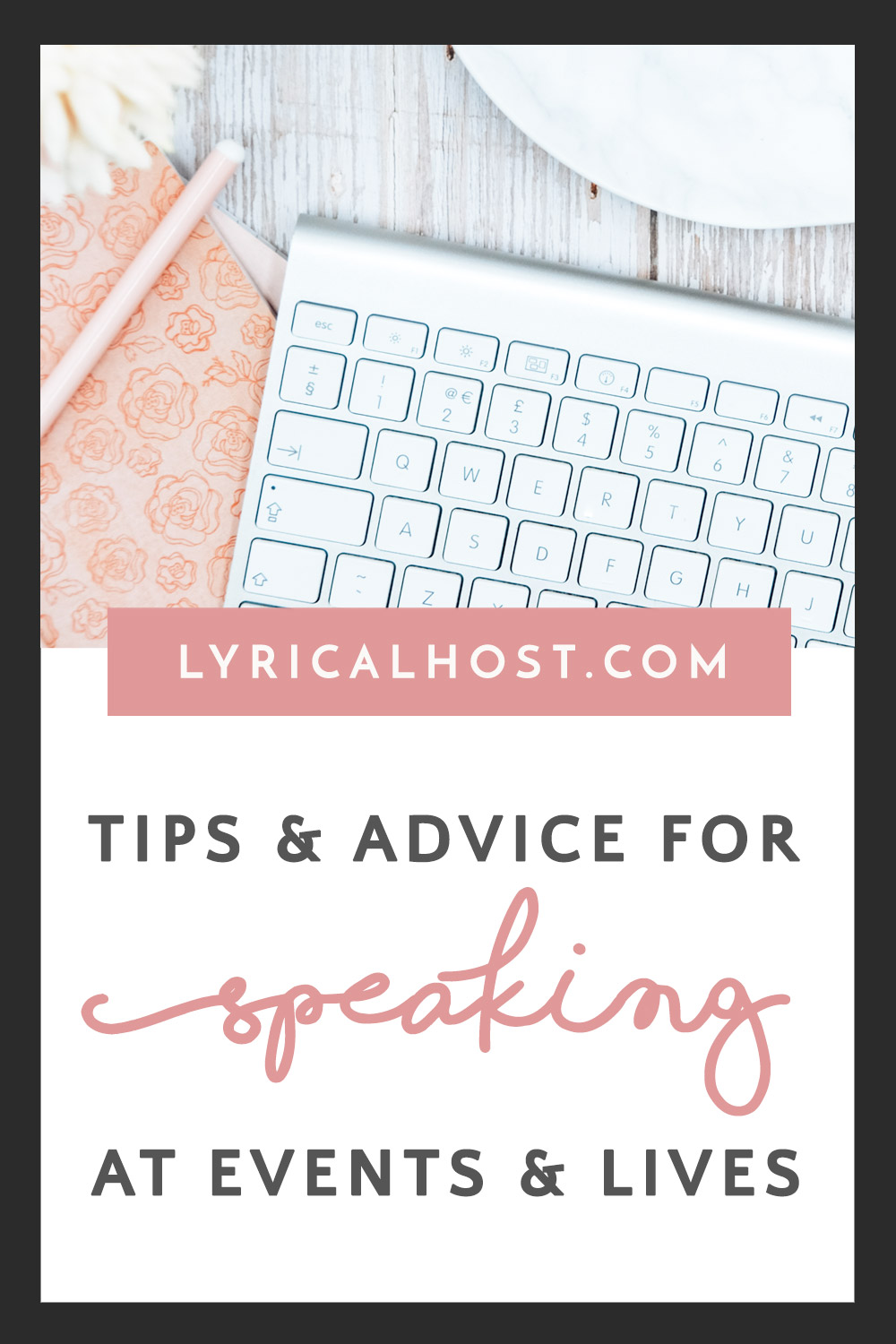If you haven’t done it much (or ever!) before, speaking at an event or doing a Live can be pretty daunting. It’s easy to overthink things, and unfortunately the best way around it is to just bite the bullet and do it. The more practise you have, the more comfortable and normal it will feel – it’s just being brave enough to put yourself out there!
Below we’ve included a whole range of different tips and snippets of advice whether you’re going live online or speaking at an in-person event.
Don’t worry, you’ve got this!
01. Prepare (minimal!) notes in advance
This may look like writing a whole bunch of notes, just writing a couple of words to remind yourself of the main topics or a reminder to do something (e.g. slow down, smile, breathe), a quote/note to reassure yourself.
A sticky note above your camera can help you avoid having to look down or reference other screens/notes, or you could use a claw grippy thing to hold your notes in place.
(Side note: Don’t write every single word down, because then you’ll be tempted to read it all out. It feels safe to you, but it can feel inauthentic to your audience).
02. Think of a good icebreaker
This can be a great way to calm your nerves as you wait for people to turn up or open with something that’s going to grab their attention while you’re preparing to start. An easy question related to what you’ll talk about can be a good way to start; it can be something your audience thinks about or quickly jots down for you to revisit at the end of the talk, or it could be something they write in the comments or chat at an online event.
03. Don’t worry about being judged on your appearance
We ran a poll in our Facebook group about expectations of appearance in videos and lives. The good news is that the majority didn’t think it was important at all, and don’t care what you’re wearing or have a particular view of how you should look or how much effort you should put in. If this is something that’s been stopping you previously, it’s time to let go of that worry. Your audience is on your side.
04. Go private before you go public
You can set a Live to only be viewable by you on platforms such as Facebook. This is a great way to practise without the pressure of an audience and watch yourself back. Check for background distractions and weirdness (you don’t want a plant looking like it’s coming out of the top of your head, for example!) and quickly identify anything you’re doing a lot, such as repeating a particular word or sound.
If you’re giving an in-person talk, you may want to visit the space and stand on the stage to get a feel for what it will be like. You could even run through your talk with a friend or family member to get some feedback and support from familiar friendly faces.
05. Remember to look in the right place
If you’re speaking at an event, this means facing forward. If you’re doing a Live or similar, that means looking directly into your camera.
Always face your audience; don’t turn around to look at the big screen or something else in your environment.
06. Outline all the sections/key areas you’re going to cover at the start
This helps your audience understand what to expect and where you’re headed. You can also take this opportunity to briefly outline the value/knowledge they can expect to gain from your talk, or where they should be at by the end of it (e.g. “more confident about X,” “in a position to do Y” and so on).
07. Make sure any slides are consistent & easy to read
If you’re using a slide deck, you can’t go through your slides enough times in advance. Check for typos, make sure fonts, colors, and sizes are consistent, and cut out anything that’s not totally vital. Don’t forget to use a super easy to read font, and ensure there’s really good contrast between text color and screen color. Remember colors on your screen may look very different to other people, depending on how their monitors have been calibrated, their eyesight, and how they perceive color.
08. Signpost where you’re going, and break it up using language and sections
Holding your audience’s attention is easier (and more effective) when you break your talk up into sections. This prevents information overload, gives their brains a small brain, and makes it easier for people to concentrate as it doesn’t feel like one long monologue. You could indicate your main sections in the header or footer of your slides, number them as “Slide 1 of X”, or if you’re feeling fancy you could even create your own progress bar graphics where the bar “fills up” the further into your slides you go. (Bonus points for having it themed in the style of your talk, e.g. a battery powering up would be great for a talk on tech!).
Signposting can also be effective through words, for example, “First I’m going to talk about X, then I’ll move on to talk about Y, and finally I’ll be wrapping up with Z.” This helps prevent your audience feeling lost or that the talk risks going on for hours!
09. Take the time to embed
If you’re using media such as video or audio, take the time to embed it directly in the slides instead of having to flick between tabs. As well as being more polished and convenient, it also helps prevent your audience seeing any embarrassing tabs, desktop images, history/autocompletes in your browser URL bar, and so on.
10. Take it slow
It’s much more common for people to speak too quickly than too slowly; if it sounds slow to you in your head, it’s probably about right. If you’re concerned speed might be an issue for you, you can always have a friend or organizer in the audience ready to indicate to you if you’re too fast or slow, or simply ask the audience to tell you. This is more likely to be something you’ll want to consider when talking to an international audience who may not follow your accent immediately.
11. Repeat the important bits
It’s easy for your audience to miss something, so anything particularly important or interesting should be repeated. This could be showing a super quick video clip twice, or repeating the most important point at the end of a section or in your wrap up.
12. Make interacting easy & pleasant
A lot of people hide inside their shells and avoid eye contact when it comes to interacting in person. Online, they often can’t think what to say. Either way, they’re seeing themselves in the role of spectator rather than participator. So if you’re including audience participation, make sure that it’s very easy and non-confrontational. Asked closed yes/no questions to a group, asking them to raise their hands to vote instead of speaking, and making sure that questions don’t require too much thought can help.
If you’re familiar with particular people in your audience, you could even ask/speak to them directly; people are more likely to answer questions when they’re asked as an individual, and if you already have that relationship there it can be more comfortable.
13. Avoid it going off-topic or becoming a rant
Your talk is likely to be something you’re very passionate about, and if you’re heading into the areas of what people or companies commonly get wrong, there’s sometimes a danger that it can turn into a rant. There are a few different approaches you can take here; limit yourself to how long you spend talking about it, end on a positive/explanation of how to avoid the mistake or turn it around, and avoid too many negative points close together.
Going off-topic isn’t always a bad thing. Personal anecdotes show you’re human and can help your audience relate to you, but make sure you keep them short and they have some kind of link to what you’re talking about!
14. Think about your references
It’s easier for someone to remember a Twitter handle than a long website URL, for example. If they’re important to what you’re talking about, you could create a handout, blog post, or signpost people to them on your social media channels if you aren’t able to drop them in the comments or email a summary.
15. Mix it up
Use different media and different approaches within your talk. For example, you could highlight a tweet, play a short clip, have a short bullet point list, ask your audience questions, grab a willing volunteer. All of these things will help your talk feel interactive and steer it away from monotony. As an added bonus, other media and people means you have a quick chance to take a drink or give your throat a break.
16. Make sure it’s accessibility friendly and inclusive
Here you’re thinking about things like colorblindness, contrast, and making sure audience members who can’t hear or see can still get access to what you’re saying. This may look like a recording or transcript after/as part of the event, making sure you describe/reference important images on your slides, and mentioning to audience members that you’re keen to be as inclusive as possible and ask if there are any ways you can help or improve on that.
If you have slides featuring people, review how inclusive your images are. We have posts on where to find the best LQBGT+, culturally diverse, body positive and disability stock photos if you’re looking for resources.
Check your language – can you be more gender neutral? Do you have a list of alternatives to words like “guys” and “ladies and gentlemen” in case your mind goes blank?
17. Keep an eye on the time
If you’re doing an online Live, it’s likely to be less of a factor for you (depending on how much free time your audience has), but in an offline talk there’s more likely to be a strict schedule the organizer wants to stick to. Keeping an eye on the computer clock or having the organizer signal how you’re doing/when you need to wrap things up can help you stay on track.
18. Offer a freebie or bonus
You can use this as an incentive for people to show up/show up live, for example by running a contest during your event, providing swag, offering them an exclusive piece of content or discount, or similar. This can also be used to get people to stay to the end, for example by saying you’ll draw the winners live at the end from the people who are still there.
19. Where to find the slides/catch a replay/grab notes
This is best mentioned near the end, for people who have turned up late and for people who want to recap. Mentioning it near the beginning is also an option, although it can mean some people lose focus, don’t pay as much attention, or miss it because they didn’t arrive at the beginning!
It’s also a good way to keep your relationship going beyond your talk, since people are more likely to remember you, subscribe to your email list, follow you on social media and so on (this is especially important for live events, especially if there are a lot of speakers, because people can lose track and forget names).
20. Finish with a good call to action
When it gets to the end of your talk, what should your audience’s next steps be? It could be following you on Twitter, buying a product or service, signing up to something, contacting you…whatever you like. Try not to give people too many options, because if they can’t decide or there’s a lot of information, they’re more likely to make no decision at all.
21. Repurpose
Now you’ve done your talk, how else can you use the content? Maybe you can turn it into a checklist for your newsletter subscribers, make it into a podcast episode, use it as blog post material, or develop it into a paid product or service. The possibilities are endless!
Want to come back to this post later or share it to help someone else? Pin it:







No Comments